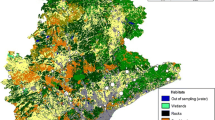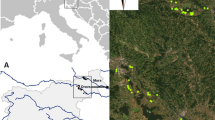Abstract
Natural habitats in human-altered landscapes are especially vulnerable to biological invasions, especially in their edges. We aim to understand the influence of landscape and local characteristics on biological invasions by exploring the level of plant invasion and alien species traits in forest edges in highly urbanized landscapes. We identified all plant species in 73 paired plots in the edge and 50 m towards the interior of the forest. We explored the association between alien species richness and similarity in species composition between edge and interior plots with landscape and local variables, using generalized linear models and variance partitioning techniques. Then, we performed Fourth-corner analyses to explore the association between alien plant traits and local and landscape variables. In contrast to native species richness, alien species richness was more affected by the surrounding landscape than by the local characteristics of the edge. Road proximity was positively associated with alien species richness and proportion and was its most important correlate, whereas disturbance was negatively associated with native species richness and was its most influential factor. Alien plant traits were also primarily associated with landscape characteristics. For instance, species of Mediterranean origin and introduced for agriculture were associated with higher agriculture use in the landscape. Our findings suggest that risk analyses of habitat vulnerability to invasion must consider the landscape context in order to successfully predict highly invaded areas and identify potentially successful invaders.

Similar content being viewed by others
References
Aubin I, Ouellette M, Legendre P, Messier C, Bouchard A (2009) Comparison of two plant functional approaches to evaluate natural restoration along an old-field—deciduous forest chronosequence. J Veg Sci 20:185–198
Bartuszevige AM, Gorchov DL, Raab L (2006) The relative importance of landscape and community features in the invasion of an exotic shrub in a fragmented landscape. Ecography 29:213–222
Beers TW, Dress PE, Wensel LC (1966) Aspect transformation in site productivity research. J For 64:691–692
Bolós O, Vigo J, Masalles RM, Ninot JM (1993) Flora Manual dels Països Catalans, 2nd edn. Pòrtic, Barcelona
Bradley BA, Mustard JF (2006) Characterizing the landscape dynamics of an invasive plant and risk of invasion using remote sensing. Ecol Appl 16:1132–1147
Brothers TS, Spingarn A (1992) Forest fragmentation and alien plant invasion of Central Indiana old-growth forests. Conserv Biol 6:91–100
Burnham KP, Anderson DR (2002) Model selection and multimodel inference: a practical information-theoretic approach, 2nd edn. Springer, New York
Cadenasso ML, Pickett STA (2001) Effect of edge structure on the flux of species into forest interiors. Conserv Biol 15:91–97
Carrete M, Grande JM, Tella JL, Sánchez-Zapata JA, Donázar JA, Díaz-Delgado R, Romo A (2007) Habitat, human pressure, and social behavior: partialling out factors affecting large-scale territory extinction in an endangered vulture. Biol Conserv 136:143–154
Castroviejo S, Lainz M, López G, Montserrat P, Muñoz F, Paiva J, Villar L (1986) Flora Ibérica. Real Jardín Botánico—CSIC, Madrid
Deutschewitz K, Lausch A, Kühn I, Klotz S (2003) Native and alien plant species richness in relation to spatial heterogeneity on a regional scale in Germany. Glob Ecol Biogeogr 12:299–311
Didham RK, Lawton JH (1999) Edge structure determines the magnitude of changes in microclimate and vegetation structure in tropical forest fragments. Biotropica 31:17–30
Didham RK, Tylianakis JM, Gemmell NJ, Rand TA, Ewers RM (2007) Interactive effects of habitat modification and species invasion on native species decline. Trends Ecol Evol 22:489–496
Dray S, Dufour A (2007) The ade4 package: implementing the duality diagram for ecologists. J Stat Softw 22:1–20
Dray S, Legendre P (2008) Testing the species traits—environment relationships: the fourth-corner problem revisited. Ecology 89:3400–3412
ESRI (2011) ArcGIS Desktop: Release 10. Environmental Systems Research Institute, Redlands, CA
Ewers RM, Didham RK (2006) Confounding factors in the detection of species responses to habitat fragmentation. Biol Rev 81:117–142
Fraver S (1994) Respuestas de la vegetación a lo largo de gradientes de borde-hacia-el interior de bosques latifoliados mixtos de la cuenca del río Roanoke, en Carolina del Norte. Conserv Biol 8:822–832
Gassó N, Sol D, Pino J, Dana ED, Lloret F, Sanz-Elorza M, Sobrino E, Vilà M (2009) Exploring species attributes and site characteristics to assess plant invasions in Spain. Divers Distrib 15:50–58
Gelman A, Hill J (2007) Data analysis using regression and multilevel/hierarchical models, 1st edn. Cambridge University Press, New York
Guirado M, Pino J, Roda F (2006) Understorey plant species richness and composition in metropolitan forest archipelagos: effects of forest size, adjacent land use and distance to the edge. Glob Ecol Biogeogr 15:50–62
Harper KA, McDonalad SE, Burton PJ, Chen J, Brosofske K, Sanders SC, Euskirchen E, Roberts D, Jaiteh M, Esseen P (2005) Edge influence on forest structure and composition in fragmented landscapes. Conserv Biol 19:768–782
Hayes KR, Barry SC (2007) Are there any consistent predictors of invasion success? Biol Invasions 10:483–506
Hobbs RJ, Huenneke LF (1992) Disturbance, diversity, and invasion: implications for conservation. Conserv Biol 6:324–337
Ibáñez I, Silander JA Jr, Allen JM, Treanor SA, Wilson A (2009) Identifying hotspots for plant invasions and forecasting focal points of further spread. J Appl Ecol 46:1219–1228
ICC (2004) Base topogràfica 1:50.000 v.3.1. Barcelona, Spain
Jauni M, Hyvönen T (2012) Interactions between alien plant species traits and habitat characteristics in agricultural landscapes in Finland. Biol Invasions 14:47–63
Kolar CS, Lodge DM (2001) Progress in invasion biology: predicting invaders. Trends Ecol Evol 16:199–204
Kumar S, Stohlgren TJ, Chong GW (2006) Spatial heterogeneity influences native and nonnative plant species richness. Ecology 87:3186–3199
Lake JC, Leishman MR (2004) Invasion success of exotic plants in natural ecosystems: the role of disturbance, plant attributes and freedom from herbivores. Biol Conserv 117:215–226
Legendre P, Galzin R, Harmelin-Vivien ML (1997) Relating behavior to habitat: solutions to the fourth-corner problem. Ecology 78:547–562
Lloret F, Medail F, Brundu G, Camarda I, Moragues E, Rita J, Lambdon P, Hulme PE (2005) Species attributes and invasion success by alien plants on Mediterranean islands. J Ecol 93:512–520
Martin PH, Canham CD, Marks PL (2009) Why forests appear resistant to exotic plant invasions: intentional introductions, stand dynamics, and the role of shade tolerance. Front Ecol Environ 7:142–149
McCune B, Grace J (2002) Analysis of ecological communities. Mjm Software Design, Gleneden Beach
McDonald RI, Urban DL (2006) Edge effects on species composition and exotic species abundance in the North Carolina piedmont. Biol Invasions 8:1049–1060
Milbau A, Stout JC, Graae BJ, Nijs I (2008) A hierarchical framework for integrating invasibility experiments incorporating different factors and spatial scales. Biol Invasions 11:941–950
Mood AM (1969) Macro-analysis of the American educational system. Oper Res 17:770–784
Ohlemüller R, Walker S, Bastow Wilson J (2006) Local vs regional factors as determinants of the invasibility of indigenous forest fragments by alien plant species. Oikos 112:493–501
Olarieta JR, Rodríguez-Valle FL, Tello E (2008) Preserving and destroying soils, transforming landscapes: soils and land-use changes in the Vallès County (Catalunya, Spain) 1853–2004. Land Use Policy 25:474–484
Pino J, Font X, Carbó J, Jové M, Pallarès L (2005) Large-scale correlates of alien plant invasion in Catalonia (NE of Spain). Biol Conserv 122:339–350
Pyšek P, Richardson DM (2007) Traits associated with invasiveness in alien plants: where do we stand? In: Nentwig W (ed) Biological invasions. Springer, Berlin, pp 97–125
R Development Core Team (2011) R: A language and environment for statistical computing. R Foundation for Statistical Computing. Vienna, Austria. ISBN 3-900051-07-0. http://www.R-project.org/
Sanz-Elorza M, Dana ED, Sobrino E (2004) Atlas de las plantas alóctonas invasoras en España. Dirección General para la Biodiversidad, Madrid
Scott JK, Panetta FD (1993) The Australian weed status of Southern African plants. J Biogeogr 20:87–93
Souza L, Bunn WA, Simberloff D, Lawton RM, Sanders NJ (2011) Biotic and abiotic influences on native and exotic richness relationship across spatial scales: favourable environments for native species are highly invasible. Funct Ecol 25:1106–1112
Sullivan JJ, Timmins SM, Williams PA (2005) Movement of exotic plants into coastal native forests from gardens in northern New Zealand. New Zeal J Ecol 29:1–10
Thuiller W, Richardson DM, Pysek P, Midgley GF, Hughes GO, Rouget M (2005) Niche-based modelling as a tool for predicting the risk of alien plant invasions at a global scale. Glob Change Biol 11:2234–2250
Thuiller W, Richardson DM, Rouget M, Procheş Ş, Wilson JRU (2006) Interactions between environment, species traits and human uses describe patterns of plant invasions. Ecology 87:1755–1769
Vilà M, Ibáñez I (2011) Plant invasions in the landscape. Landsc Ecol 26:461–472
With KA (2004) Assessing the risk of invasive spread in fragmented landscapes. Risk Anal 24:803–815
Acknowledgments
We are very grateful to the Global Change Ecology Lab of University of Michigan whose comments significantly improved the manuscript. This research was partially funded by the Spanish Ministerio de Ciencia e Innovación projects Consolider-Ingenio MONTES (CSD2008-00040) and RIXFUTUR (CGL2009-7515), and the Junta de Andalucía project RNM-4031. We also thank two anonymous reviewers for their comments and advice.
Author information
Authors and Affiliations
Corresponding author
Electronic supplementary material
Below is the link to the electronic supplementary material.
Rights and permissions
About this article
Cite this article
González-Moreno, P., Pino, J., Gassó, N. et al. Landscape context modulates alien plant invasion in Mediterranean forest edges. Biol Invasions 15, 547–557 (2013). https://doi.org/10.1007/s10530-012-0306-x
Received:
Accepted:
Published:
Issue Date:
DOI: https://doi.org/10.1007/s10530-012-0306-x




